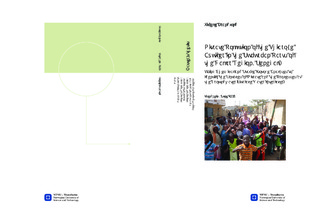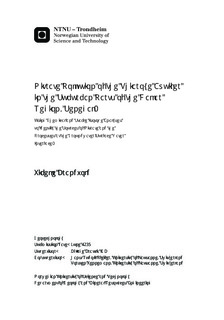| dc.description.abstract | The current report, with the title Nitrate pollution of the Thiaroye aquifer in the suburban parts of the Dakar Region, Senegal ? Using chemical and stable isotope analyses to identify the sources of nitrate and the processes at the groundwater/surface water interface, constitutes the master thesis of Vibeke Brandvold. The thesis is made up by a total of 102 pages + appendices and was written in the 2013 spring semester. Flooding is a major problem in the departments of Pikine and Guédiawaye, in the suburban parts of the Dakar Region, Senegal. The region is very densely habited, but no public wastewater system is developed. Sanitary facilities consist of pit latrines and permeable septic tanks. The groundwater of the Thiaroye aquifer is, in this region, polluted with concentrations of nitrate that largely exceeds the WHO regulatory limit of 50 mg-NO3/L for drinking water. Today, drinking water is transported from Lake Guiers, in the northeast of Senegal, and from the Sebikotane aquifer, southeast of Dakar. Some families have a hand-operated pump, called Diambar pump, which extracts water from the uppermost part of the groundwater. This water is mainly used for domestic purposes like washing and given to animals, but it is not suited as drinking water. Almost all of the wastewater in the region infiltrates into the ground and recharges the aquifer. Precipitation is the only other source of recharge. Many areas are flooded throughout the year and especially during the rainy season from July to October, when surface runoff collects in low-lying areas. To reduce the extent of flooding, several retention pools, 3-4 m deep, have been constructed. In the region there are also areas of urban agriculture, called the ?Niayes?.During the work on this master thesis, the water qualities of the groundwater of the Thiaroye aquifer and of different surface waters in the suburban areas of the Dakar Region were studied. 34 samples from Diambar pumps, dug wells, flooded zones, Niayes and retention pools were analysed for the contents of anions, cations, organic and inorganic carbon, together with stable environmental isotopes of water (2H/1H and 18O/16O), nitrate (15N/14N and 18O/16O) and algae (15N/14N). The research was especially focused on the pollution of nitrate, in hopes of being able to identify the sources of nitrate and the processes that happen at the ground-/surface water interface. The surface waters have in general higher conductivities and concentrations of salts than the groundwater, due to more extensive evaporation. The isotopic composition of water was used to quantify the extent of evaporation from both the groundwater and the surface waters, and it has given new insight to the hydrological connectivity at the ground-/surface water interface. The hypothesis that there is a good connection between the waters, and that the groundwater recharges the surface waters during the rainy season, have been strengthened. The groundwater is very rich in nitrate, with concentration ranging from 76 to 785 mg/L, which is a result of leaking pit latrines and septic tanks. The isotopic composition of nitrogen and oxygen in the nitrate (mean d18O = +7.8 ? and d15N = 12.2 ? in the Diambar pumps) show clearly that the nitrate originates from human wastes, and to a certain extent from organic fertilisers and the degradation of organic nitrogen. The surface waters contain almost no nitrate, but the processes responsible for this lowering are still not fully understood. The main process is most likely the uptake of nitrate by aquatic plants and algae. This is witnessed by the negative correlation between the amounts of organic matter vs. nitrate, the obvious eutrophic state of the surface waters, together with the enriched values of d15N of the algae (d15NAlgae up to +25 ?). The isotopic composition of nitrate in the surface waters are enriched with around 18 ? for the N and 22 ? for the O, compared to the surrounding groundwater. This could suggest that denitrification is taking place. However, the results obtained are only indicative, and other indications are ambiguous. Thus, it cannot be concluded nor excluded that denitrification is an important process in the lowering of the nitrate concentrations in the surface waters. Other possible processes that contribute to the reduction and/or fractionation of the nitrate are remineralisation of organic nitrogen and volatilisation of ammonia. Dilution by mixing with precipitation does not contribute significantly to the sink of nitrate in the surface waters. | nb_NO |

